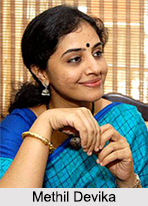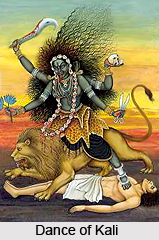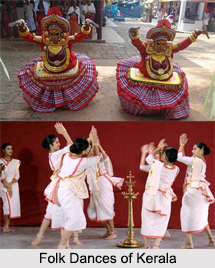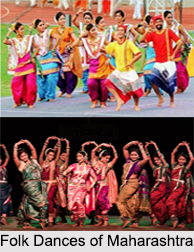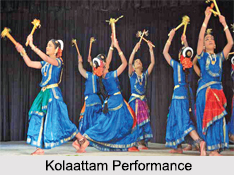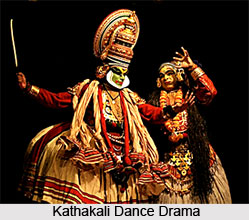 Kathakali symbolises the cultural blend of both Aryans and Dravidians. It is a perfect idealized art in which acting, dancing and music exist in perfect union. The dance form has come to be known as the most histrionic art of the Orient and has caught worldwide attention. Elaborate gesture, picturesque costume, grand make-up and vigorous music are the chief ingredients of Kathakali dance. It has the elements of both dance art and dramatic art. Every kind of emotions is expressed by the actors of Kathakali dance through their vivid facial gestures. The dance form not only involves subjective emotions of the human heart but at the same time it also involves the objective realisation of the persons, scenes and creatures all around. As Kathakali is a traditional art form it involves several rituals and customs which have continued till date.
Kathakali symbolises the cultural blend of both Aryans and Dravidians. It is a perfect idealized art in which acting, dancing and music exist in perfect union. The dance form has come to be known as the most histrionic art of the Orient and has caught worldwide attention. Elaborate gesture, picturesque costume, grand make-up and vigorous music are the chief ingredients of Kathakali dance. It has the elements of both dance art and dramatic art. Every kind of emotions is expressed by the actors of Kathakali dance through their vivid facial gestures. The dance form not only involves subjective emotions of the human heart but at the same time it also involves the objective realisation of the persons, scenes and creatures all around. As Kathakali is a traditional art form it involves several rituals and customs which have continued till date.
The Kathakali dance drama is embedded with a number of rituals. In the very beginning Keli is performed just before the sunset. This particular ritual announces the fact that later in the same venue a Kathakali performance will take place. Immediately after the Keli the performers prepare for the Chutty that is the face make up which is used by the performers. This facial make up takes around an hour and a half.
Before the original play begins a number of rituals are performed in the place of the performance. If Kathakali is the only item to be performed at night then a light is lit at eight o` clock. Traditionally this light is lit by a costume assistant using a wick from the green room.
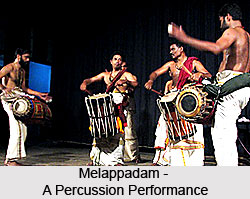 An auspicious ritual just before the play involves Arangukeli. In this ritual only Maddalam gong and the cymbals are used. The Maddalam generally represents "Dundubhi" which are large drums of the ancient age and are considered auspicious. In the early times as the ritual of Arangukeli was in progress a junior artist used to offer salutation to Lord Ganesha.
An auspicious ritual just before the play involves Arangukeli. In this ritual only Maddalam gong and the cymbals are used. The Maddalam generally represents "Dundubhi" which are large drums of the ancient age and are considered auspicious. In the early times as the ritual of Arangukeli was in progress a junior artist used to offer salutation to Lord Ganesha.
Soon after the Arangukeli ends the curtain is held aloft by two persons and the singers start with a Vandanalaslokam" which is basically a praising hymn for the favourite deities. The next item in the Kathakali ritual involves Thodayam whereby the junior actors in their training attire perform a dance sequence inside the curtain. This particular dance involves all the four rhythms used in Kathakali and the lyrics of the song sung also involve hymns sung for the Hindu mythological god.
Thodayam is followed by Purappad. At this juncture Kathakali dance drama makes use of Chenda. Previously this particular dance form was performed by the hero and his spouse but in the present age this is no more performed by the main actors but is performed by junior actors who usually dress up like up Lord Krishna and Rukmini.
Melappadam is also a percussion performance and shows the grade of the performance. This performance is basically a confluence of tunes and rhythms and is a feast for those who are musically inclined.
It is after Melappadam that the real play begins. Besides the customs of Pacha and Minukku which are associated with the entry ritual of Kathakali another important ritual which is an integral part of the dance drama is "Thiranokku".
Kathakali is an elaborate gesture it involves a number of parts. For instance, Cholliyatam is that part of the dance drama which involves enactment of the dialogues which follows the lyrics of the songs sung. Cholliyatam involves three major parts in it. Pathinjattam involves extremely slow performance and every expression is given in detail and usually involves the romantic scenes. Cholliyatam in the medium tempo is used most commonly in the Kathakali dance drama. This is used mostly to depict scenes of battles and confrontation. In this particular dance form the hands are moved in real rapid gesture and quick succession. Chenda is rarely used in Cholliyatam. As percussion music there is use of `Kalasam`. Kalasam also includes several varieties like Iratty, Vattam etc.
Another part of Kathakali involves the Ilakiyattam. In Ilakiyattam the end part involves acting without any vocal support. The use of this part is mostly to enact those parts of the stories which had been left out by the lyricist.
Just as rituals and customs play an important role in Kathakali in the similar manner props, make-up and attire also play a vital role in making a Kathakali performance successful. Curtain or the Thirasseela is a must for any kind of Kathakali performance. It was a custom to use a single piece of cloth which had to be mono- coloured and had to bear the emblem of a lotus or the image of the favourite deity. The lamp is also an important prop of any Kathakali play. Before the discovery of lights an oil lamp was generally used in order to light up the faces of the actors. The next prop which is commonly used is a stool. The stool is generally used for the actors to sit on it according to the requirement of the play.
Hence it can be concluded saying that Kathakali which is a traditional dance form has several customs associated with it and it is these customs and rituals which add to the glory of the Indian dance drama.
